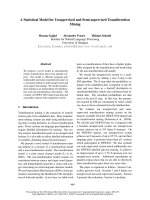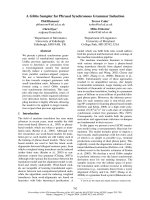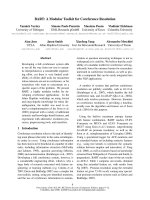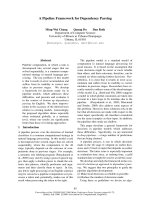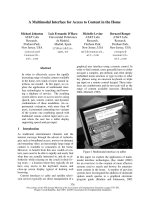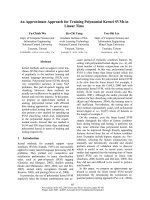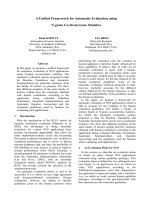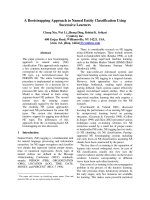Báo cáo khoa học: "A Clustering Approach for the Nearly Unsupervised Recognition of Nonliteral Language" pdf
Bạn đang xem bản rút gọn của tài liệu. Xem và tải ngay bản đầy đủ của tài liệu tại đây (329.3 KB, 8 trang )
A Clustering Appro ach for the Nearly Unsupervised Recognition of
Nonliteral Language
∗
Julia Birke and Anoop Sarkar
School of Computing Science, Simon Fraser University
Burnaby, BC, V5A 1S6, Canada
,
Abstract
In this paper we present TroFi (Trope
Finder), a system for automatically classi-
fying literal and nonliteral usages of verbs
through nearly unsupervised word-sense
disambiguation and clustering techniques.
TroFi uses sentential context instead of
selectional constraint violations or paths
in semantic hierarchies. It also uses lit-
eral and nonliteral seed sets acquired and
cleaned without human supervision in or-
der to bootstrap learning. We adapt a
word-sense disambiguation algorithm to
our task and augment it with multiple seed
set learners, a voting schema, and addi-
tional features like SuperTags and extra-
sentential context. Detailed experiments
on hand-annotated data show that our en-
hanced algorithm outperforms the base-
line by 24.4%. Using the TroFi algo-
rithm, w e also build the TroFi Example
Base, an extensible resource of annotated
literal/nonliteral examples which is freely
available to the NLP research community.
1 Introduction
In this paper, we propose TroFi (Trope F inder),
a nearly unsupervised clustering method for sep-
arating literal and nonliteral usages of verbs. For
example, given the target verb “pour”, we would
expect TroFi to cluster the sentence “Custom
demands that cognac be poured from a freshly
opened bottle” as literal, and the sentence “Salsa
and rap music pour out of the windows” as nonlit-
eral, which, indeed, it does. We call our method
nearly unsupervised. See Section 3.1 for why we
use this terminology.
We reduce the problem of nonliteral language
recognition to one of word-sense disambiguation
∗
This research was partially supported by NSERC,
Canada (RGPIN: 264905). We would like to thank Bill
Dolan, Fred Popowich, Dan Fass, Katja Markert, Yudong
Liu, and the anonymous reviewers for their comments.
by redefining literal and nonliteral as two differ-
ent senses of the same word, and we adapt an ex-
isting similarity-based word-sense disambiguation
method to the task of separating usages of verbs
into literal and nonliteral clusters. This paper fo-
cuses on the algorithmic enhancements necessary
to facilitate this transformation from word-sense
disambiguation to nonliteral language recognition.
The output of TroFi is an expandable example base
of literal/nonliteral clusters which is freely avail-
able to the research community.
Many systems that use NLP methods – such as
dialogue systems, paraphrasing and summariza-
tion, language generation, information extraction,
machine translation, etc. – would benefit from be-
ing able to recognize nonliteral language. Con-
sider an example based on a similar example from
an automated medical claims processing system.
We must determine that the sentence “she hit the
ceiling” is meant literally before it can be marked
up as an ACCID ENT claim. Note that the typical
use of “hit the ceiling” stored in a list of idioms
cannot help us. Only using the context, “She broke
her thumb while she was cheering for the Patriots
and, in her excitement, she hit the ceiling,” can we
decide.
We further motivate the usefulness of the abil-
ity to recognize literal vs. nonliteral usages using
an example from the Recognizing Textual Entail-
ment (RTE -1) challenge of 2005. (This is just an
example; we do not compute entailments.) In the
challenge data, Pair 1959 was: Kerry hit Bush hard
on his conduct on the war in Iraq. → Kerry shot
Bush. The objective was to report FALSE since
the second statement in this case is not entailed
from the first one. In order to do this, it is cru-
cial to know that “hit” is being used nonliterally in
the first sentence. Ideally, we would like to look
at TroFi as a first step towards an unsupervised,
scalable, widely applicable approach to nonliteral
language processing that works on real-world data
from any domain in any language.
329
2 Previous Work
The foundations of TroFi lie in a rich collec-
tion of metaphor and metonymy processing sys-
tems: everything from hand-coded rule-based sys-
tems to statistical systems trained on large cor-
pora. Rule-based systems – some using a type
of interlingua (Russell, 1976); others using com-
plicated networks and hierarchies often referred
to as metaphor maps (e.g. (Fass, 1997; Martin,
1990; Martin, 1992) – must be largely hand-coded
and generally work well on an enumerable set
of metaphors or in limited domains. Dictionary-
based systems use existing machine-readable dic-
tionaries and path lengths between words as one
of their primary sources for metaphor processing
information (e.g. (Dolan, 1995)). Corpus-based
systems primarily extract or learn the necessary
metaphor-processing information from large cor-
pora, thus avoiding the need for manual annota-
tion or metaphor-map construction. Examples of
such systems can be found in (Murata et. al., 2000;
Nissim & Markert, 2003; Mason, 2004). The work
on supervised metonymy resolution by Nissim &
Markert and the work on conceptual metaphors by
Mason come closest to what we are trying to do
with TroFi.
Nissim & Markert (2003) approach metonymy
resolution with machine learning methods, “which
[exploit] the similarity between examples of con-
ventional metonymy” ((Nissim & Markert, 2003),
p. 56). They see metonymy resolution as a classi-
fication problem between the literal use of a word
and a number of pre-defined metonymy types.
They use similarities between possibly metonymic
words (PMWs) and known metonymies as well as
context similarities to classify the PMWs. The
main difference between the Nissim & Markert al-
gorithm and the TroFi algorithm – besides the fact
that Nissim & Markert deal with specific types
of metonymy and not a generalized category of
nonliteral language – is that Nissim & Markert
use a supervised machine learning algorithm, as
opposed to the primarily unsupervised algorithm
used by TroFi.
Mason (2004) presents CorMet, “a corpus-
based system for discovering metaphorical map-
pings between concepts” ((Mason, 2004), p. 23).
His system finds the selectional restrictions of
given verbs in particular domains by statistical
means. It then finds metaphorical mappings be-
tween domains based on these selectional prefer-
ences. By finding semantic differences between
the selectional preferences, it can “articulate the
higher-order structure of conceptual metaphors”
((Mason, 2004), p. 24), finding mappings like
LIQUID→MONEY. Like CorMet, TroFi uses
contextual evidence taken from a large corpus and
also uses WordNet as a primary knowledge source,
but unlike CorMet, TroFi does not use selectional
preferences.
Metaphor processing has even been ap-
proached with connectionist systems storing
world-knowledge as probabilistic dependencies
(Narayanan, 1999).
3 TroFi
TroFi is not a m etaphor processing system. It does
not claim to interpret metonymy and it will not tell
you what a given idiom means. Rather, TroFi at-
tempts to separate literal usages of verbs from non-
literal ones.
For the purposes of this paper we will take the
simplified view that literal is anything that falls
within accepted selectional restrictions (“he was
forced to eat his spinach” vs. “he was forced to eat
his words”) or our knowledge of the world (“the
sponge absorbed the water” vs. “the company
absorbed the loss”). Nonliteral is then anything
that is “not literal”, including most tropes, such as
metaphors, idioms, as well phrasal verbs and other
anomalous expressions that cannot really be seen
as literal. In terms of metonymy, TroFi may clus-
ter a verb used in a metonymic expression such as
“I read Keats” as nonliteral, but we make no strong
claims about this.
3.1 The Data
The TroFi algorithm requires a target set (called
original set in (Karov & Edelman, 1998)) – the
set of sentences containing the verbs to be classi-
fied into literal or nonliteral – and the seed sets:
the literal feedback set and the nonliteral feed-
back set. These sets contain feature lists consist-
ing of the stemmed nouns and verbs in a sentence,
with target or seed words and frequent words re-
moved. The frequent word list (374 words) con-
sists of the 332 most frequent words in the British
National Corpus plus contractions, single letters,
and numbers from 0-10. The target set is built us-
ing the ’88-’89 Wall Street Journal Corpus (WSJ)
tagged using the (Ratnaparkhi, 1996) tagger and
the (Bangalore & Joshi, 1999) SuperTagger; the
feedback sets are built using WSJ sentences con-
330
Algorithm 1 KE-train: (Karov & Edelman, 1998) algorithm adapted to literal/nonliteral classification
Require: S: the set of sentences containing the target word
Require: L: the set of literal seed sentences
Require: N : the set of nonliteral seed sentences
Require: W: the set of words/features, w ∈ s means w is in sentence s, s w means s contains w
Require: : threshold that determines the stopping condition
1: w-sim
0
(w
x
, w
y
) := 1 if w
x
= w
y
, 0 otherwise
2: s-sim
I
0
(s
x
, s
y
) := 1, for all s
x
, s
y
∈ S × S where s
x
= s
y
, 0 otherwise
3: i := 0
4: while (true) do
5: s-sim
L
i+1
(s
x
, s
y
) :=
w
x
∈s
x
p(w
x
, s
x
) max
w
y
∈s
y
w-sim
i
(w
x
, w
y
), for all s
x
, s
y
∈ S × L
6: s-sim
N
i+1
(s
x
, s
y
) :=
w
x
∈s
x
p(w
x
, s
x
) max
w
y
∈s
y
w-sim
i
(w
x
, w
y
), for all s
x
, s
y
∈ S × N
7: for w
x
, w
y
∈ W × W do
8: w-sim
i+1
(w
x
, w
y
) :=
i = 0
s
x
w
x
p(w
x
, s
x
) max
s
y
w
y
s-sim
I
i
(s
x
, s
y
)
else
s
x
w
x
p(w
x
, s
x
) max
s
y
w
y
{s-sim
L
i
(s
x
, s
y
), s-sim
N
i
(s
x
, s
y
)}
9: end for
10: if ∀w
x
, max
w
y
{w-sim
i+1
(w
x
, w
y
) − w-sim
i
(w
x
, w
y
)} ≤ then
11: break # algorithm converges in
1
steps.
12: end if
13: i := i + 1
14: end while
taining seed words extracted from WordNet and
the databases of known metaphors, idioms, and
expressions (DoKMIE), namely Wayne Magnu-
son English Idioms Sayings & Slang and George
Lakoff’s Conceptual Metaphor List, as well as ex-
ample sentences from these sources. (See Section
4 for the sizes of the target and feedback sets.) One
may ask why we need TroFi if we have databases
like the DoKMIE. The reason is that the DoKMIE
are unlikely to list all possible instances of non-
literal language and because knowing that an ex-
pression can be used nonliterally does not mean
that you can tell when it is being used nonliter-
ally. The target verbs may not, and typically do
not, appear in the feedback sets. In addition, the
feedback sets are noisy and not annotated by any
human, which is why we call TroFi unsupervised.
When we use WordNet as a source of example sen-
tences, or of seed words for pulling sentences out
of the WSJ, for building the literal feedback set,
we cannot tell if the WordNet synsets, or the col-
lected feature sets, are actually literal. We provide
some automatic methods in Section 3.3 to ensure
that the feedback set feature sets that will harm us
in the clustering phase are removed. As a side-
effect, we may fill out sparse nonliteral sets.
In the next section we look at the Core TroFi
algorithm and its use of the above data sources.
3.2 Core Algorithm
Since we are attempting to reduce the problem of
literal/nonliteral recognition to one of word-sense
disambiguation, TroFi makes use of an existing
similarity-based word-sense disambiguation algo-
rithm developed by (Karov & Edelman, 1998),
henceforth KE.
The KE algorithm is based on the principle of
attraction: similarities are calculated between sen-
tences containing the word we wish to disam-
biguate (the target word) and collections of seed
sentences (feedback sets) (see also Section 3.1).
A target set sentence is considered to be at-
tracted to the feedback set containing the sentence
to which it shows the highest similarity. Two sen-
tences are similar if they contain similar words and
two words are similar if they are contained in sim-
ilar sentences. The resulting transitive similarity
allows us to defeat the knowledge acquisition bot-
tleneck – i.e. the low likelihood of finding all pos-
sible usages of a word in a single corpus. Note
that the KE algorithm concentrates on similarities
in the way sentences use the target literal or non-
literal word, not on similarities in the meanings of
the sentences themselves.
Algorithms 1 and 2 summarize the basic TroFi
version of the KE algorithm. Note that p(w, s) is
the unigram probability of word w in sentence s,
331
Algorithm 2 KE-test: classifying literal/nonliteral
1: For any sentence s
x
∈ S
2: if
max
s
y
s-sim
L
(s
x
, s
y
) >
max
s
y
s-sim
N
(s
x
, s
y
)
then
3: tag s
x
as literal
4: else
5: tag s
x
as nonliteral
6: end if
normalized by the total number of words in s.
In practice, initializing s-sim
I
0
in line (2) of
Algorithm 1 to 0 and then updating it from
w-sim
0
means that each target sentence is still
maximally similar to itself, but w e also dis-
cover additional similarities between target sen-
tences. We further enhance the algorithm
by using Sum of Similarities. To implement
this, in Algorithm 2 we change line (2) into:
s
y
s-sim
L
(s
x
, s
y
) >
s
y
s-sim
N
(s
x
, s
y
)
Although it is appropriate for fine-grained tasks
like word-sense disambiguation to use the single
highest similarity score in order to minimize noise,
summing across all the similarities of a target set
sentence to the feedback set sentences is more
appropriate for literal/nonliteral clustering, where
the usages could be spread across numerous sen-
tences in the feedback sets. We make another
modification to Algorithm 2 by checking that the
maximum sentence similarity in line (2) is above a
certain threshold for classification. If the similar-
ity is above this threshold, we label a target-word
sentence as literal or nonliteral.
Before continuing, let us look at an example.
The features are shown in bold.
Target Set
1 The girl and her brother grasped their mother’s hand.
2 He thinks he has grasped the essentials of the institute’s
finance philosophies.
3 The president failed to grasp ACTech’s finance quand ary.
Literal Feedback Set
L1 The man’s aging mother gripped her husband’s
shoulders tightly.
L2 The child gripped her sister’s hand to cross the road.
L3 The president just doesn’t get the picture, does he?
Nonliteral Feedback Set
N1 After much thought, he finally grasped the idea.
N2 This idea is risky, but it looks like the director of the
institute has comprehended the basic principles behind it.
N3 Mrs. Fipps is having trouble comprehending the legal
straits of the institute.
N4 She had a hand in his fully comprehending the quandary.
The target set consists of sentences from the
corpus containing the target word. The feedback
sets contain sentences from the corpus containing
synonyms of the target word found in WordNet
(literal feedback set) and the DoKMIE (nonliteral
feedback set). The feedback sets also contain ex-
ample sentences provided in the target-word en-
tries of these datasets. TroFi attempts to cluster the
target set sentences into literal and nonliteral by
attracting them to the corresponding feature sets
using Algorithms 1 & 2. Using the basic KE algo-
rithm, target sentence 2 is correctly attracted to the
nonliteral set, and sentences 1 and 3 are equally
attracted to both sets. When we apply our sum of
similarities enhancement, sentence 1 is correctly
attracted to the literal set, but sentence 3 is now in-
correctly attracted to the literal set too. In the fol-
lowing sections we describe some enhancements –
Learners & Voting, SuperTags, and C ontext – that
try to solve the problem of incorrect attractions.
3.3 Cleaning the Feedback Sets
In this section we describe how we clean up the
feedback sets to improve the performance of the
Core algorithm. We also introduce the notion of
Learners & Voting.
Recall that neither the raw data nor the collected
feedback sets are manually annotated for training
purposes. Since, in addition, the feedback sets are
collected automatically, they are very noisy. For
instance, in the example in Section 3.2, the lit-
eral feedback set sentence L3 contains an idiom
which was provided as an example sentence in
WordNet as a synonym for “grasp”. In N4, we
have the side-effect feature “hand”, which unfor-
tunately overlaps with the feature “hand” that we
might hope to find in the literal set (e.g. “grasp his
hand”). In order to remove sources of false attrac-
tion like these, we introduce the notion of scrub-
bing. Scrubbing is founded on a few basic prin-
ciples. The first is that the contents of the D oK-
MIE come from (third-party) human annotations
and are thus trusted. Consequently we take them
as primary and use them to scrub the WordNet
synsets. The second is that phrasal and expres-
sion verbs, for example “throw away”, are often
indicative of nonliteral uses of verbs – i.e. they are
not the sum of their parts – so they can be used
for scrubbing. The third is that content words ap-
pearing in both feedback sets – for example “the
wind is blowing” vs. “the winds of war are blow-
ing” for the target word “blow” – will lead to im-
pure feedback sets, a situation we want to avoid.
The fourth is that our scrubbing action can take a
number of different forms: we can choose to scrub
332
just a word, a whole synset, or even an entire fea-
ture set. In addition, we can either move the of-
fending item to the opposite feedback set or re-
move it altogether. Moving synsets or feature sets
can add valuable content to one feedback set while
removing noise from the other. However, it can
also cause unforeseen contamination. We experi-
mented with a number of these options to produce
a whole complement of feedback set learners for
classifying the target sentences. Ideally this will
allow the different learners to correct each other.
For Learner A, we use phrasal/expression verbs
and overlap as indicators to select whole Word-
Net synsets for moving over to the nonliteral feed-
back set. In our example, this causes L1-L3 to
be moved to the nonliteral set. For Learner B,
we use phrasal/expression verbs and overlap as
indicators to remove problematic synsets. Thus
we avoid accidentally contaminating the nonliteral
set. However, we do end up throwing away infor-
mation that could have been used to pad out sparse
nonliteral sets. In our example, this causes L1-L3
to be dropped. For Learner C, we remove feature
sets from the final literal and nonliteral feedback
sets based on overlapping words. In our exam-
ple, this causes L2 and N4 to be dropped. Learner
D is the baseline – no scrubbing. We simply use
the basic algorithm. Each learner has benefits and
shortcomings. In order to maximize the former
and minimize the latter, instead of choosing the
single most successful learner, we introduce a vot-
ing system. We use a simple majority-rules algo-
rithm, with the strongest learners weighted more
heavily. In our experiments we double the weights
of Learners A and D. In our example, this results
in sentence 3 now being correctly attracted to the
nonliteral set.
3.4 Additional Features
Even before voting, we attempt to improve the cor-
rectness of initial attractions through the use of
SuperTags, which allows us to add internal struc-
ture information to the bag-of-words feature lists.
SuperTags (Bangalore & Joshi, 1999) encode a
great deal of syntactic information in a single tag
(each tag is an elementary tree from the XTAG
English Tree Adjoining Grammar). In addition
to a word’s part of speech, they also encode in-
formation about its location in a syntactic tree –
i.e. we learn something about the surrounding
words as well. We devised a SuperTag trigram
composed of the SuperTag of the target word and
the following two words and their SuperTags if
they contain nouns, prepositions, particles, or ad-
verbs. This is helpful in cases where the same
set of features can be used as part of both literal
and nonliteral expressions. For example, turning
“It’s hard to kick a habit like drinking” into “habit
drink kick/B
nx0Vpls1 habit/A NXN,” results in
a higher attraction to sentences about “kicking
habits” than to sentences like “She has a habit of
kicking me when she’s been drinking.”
Note that the creation of Learners A and B
changes if SuperTags are used. In the origi-
nal version, we only move or remove synsets
based on phrasal/expression verbs and overlapping
words. If SuperTags are used, we also move or
remove feature sets whose SuperTag trigram indi-
cates phrasal verbs (verb-particle expressions).
A final enhancement involves extending the
context to help with disambiguation. Sometimes
critical disambiguation features are contained not
in the sentence with the target word, but in an
adjacent sentence. To add context, we simply
group the sentence containing the target word with
a specified number of surrounding sentences and
turn the whole group into a single feature set.
4 Results
TroFi was evaluated on the 25 target words listed
in Table 1. The target sets contain from 1 to 115
manually annotated sentences for each verb. The
first round of annotations was done by the first an-
notator. The second annotator was given no in-
structions besides a few examples of literal and
nonliteral usage (not covering all target verbs).
The authors of this paper were the annotators. Our
inter-annotator agreement on the annotations used
as test data in the experiments in this paper is quite
high. κ (Cohen) and κ (S&C) on a random sam-
ple of 200 annotated examples annotated by two
different annotators was found to be 0.77. A s per
((Di Eugenio & Glass, 2004), cf. refs therein), the
standard assessment for κ values is that tentative
conclusions on agreement exists when .67 ≤ κ <
.8, and a definite conclusion on agreement exists
when κ ≥ .8.
In the case of a larger scale annotation effort,
having the person leading the effort provide one
or two examples of literal and nonliteral usages
for each target verb to each annotator would al-
most certainly improve inter-annotator agreement.
Table 1 lists the total number of target sentences,
plus the manually evaluated literal and nonliteral
333
counts, for each target word. It also provides the
feedback set sizes for each target word. The to-
tals across all words are given at the bottom of the
table.
absorb assault di e drag drown
Lit Target 4 3 24 12 4
Nonlit Target 62 0 11 41 1
Target 66 3 35 53 5
Lit FB 286 119 315 118 25
Nonlit FB 1 0 7 241 21
escape examine fill fix flow
Lit Target 24 49 47 39 10
Nonlit Target 39 37 40 16 31
Target 63 86 87 55 41
Lit FB 124 371 244 953 74
Nonlit FB 2 2 66 279 2
grab grasp kick knock lend
Lit Target 5 1 10 11 77
Nonlit Target 13 4 26 29 15
Target 18 5 36 40 92
Lit FB 76 36 19 60 641
Nonlit FB 58 2 172 720 1
miss pass rest ride roll
Lit Target 58 0 8 22 25
Nonlit Target 40 1 20 26 46
Target 98 1 28 48 71
Lit FB 236 1443 42 221 132
Nonlit FB 13 156 6 8 74
smooth step stick strike touch
Lit Target 0 12 8 51 13
Nonlit Target 11 94 73 64 41
Target 11 106 81 115 54
Lit FB 28 5 132 693 904
Nonlit FB 75 517 546 351 406
Totals: Target=1298; Lit FB=7297; Nonlit FB=3726
Table 1: Target and Feedback Set Sizes.
The algorithms were evaluated based on how
accurately they clustered the hand-annotated sen-
tences. Sentences that were attracted to neither
cluster or were equally attracted to both were put
in the opposite set from their label, making a fail-
ure to cluster a sentence an incorrect clustering.
Evaluation results were recorded as recall, pre-
cision, and f-score values. Literal recall is defined
as (correct literals in literal cluster / total correct
literals). Literal precision is defined as (correct
literals in literal cluster / size of literal cluster).
If there are no literals, literal recall is 100%; lit-
eral precision is 100% if there are no nonliterals in
the literal cluster and 0% otherwise. The f-score
is defined as (2 · precision · recall) / (precision
+ recall). Nonliteral precision and recall are de-
fined similarly. Average precision is the average
of literal and nonliteral precision; similarly for av-
erage recall. For overall performance, we take the
f-score of average precision and average recall.
We calculated two baselines for each word. T he
first was a simple majority-rules baseline. Due to
the imbalance of literal and nonliteral examples,
this baseline ranges from 60.9% to 66.7% with an
average of 63.6%. Keep in mind though that us-
ing this baseline, the f-score for the nonliteral set
will always be 0%. We come back to this point
at the end of this section. We calculated a sec-
ond baseline using a simple attraction algorithm.
Each target set sentence is attracted to the feed-
back set containing the sentence with which it has
the most words in common. This corresponds well
to the basic highest similarity TroFi algorithm.
Sentences attracted to neither, or equally to both,
sets are put in the opposite cluster to where they
belong. Since this baseline actually attempts to
distinguish between literal and nonliteral and uses
all the data used by the TroFi algorithm, it is the
one we will refer to in our discussion below.
Experiments were conducted to first find the
results of the core algorithm and then determine
the effects of each enhancement. The results are
shown in Figure 1. The last column in the graph
shows the average across all the target verbs.
On average, the basic TroFi algorithm (KE)
gives a 7.6% improvement over the baseline, with
some words, like “lend” and “touch”, having
higher results due to transitivity of similarity. For
our sum of similarities enhancement, all the in-
dividual target word results except for “examine”
sit above the baseline. The dip is due to the fact
that while TroFi can generate some beneficial sim-
ilarities between words related by context, it can
also generate some detrimental ones. When we
use sum of similarities, it is possible for the tran-
sitively discovered indirect similarities between a
target nonliteral sentence and all the sentences in a
feedback set to add up to more than a single direct
similarity between the target sentence and a single
feedback set sentence. This is not possible with
highest similarity because a single sentence would
have to show a higher similarity to the target sen-
tence than that produced by sharing an identical
word, which is unlikely since transitively discov-
ered similarities generally do not add up to 1. So,
although highest similarity occasionally produces
better results than using sum of similarities, on av-
erage we can expect to get better results with the
latter. In this experiment alone, we get an average
f-score of 46.3% for the sum of similarities results
– a 9.4% improvement over the high similarity re-
sults (36.9%) and a 16.9% improvement over the
baseline (29.4%).
334
Figure 1: TroFi E valuation Results.
In comparing the individual results of all our
learners, we found that the results for Learners A
and D (46.7% and 46.3%) eclipsed Learners B and
C by just over 2.5%. Using majority-rules voting
with Learners A and D doubled, we were able to
obtain an average f-score of 48.4%, show ing that
voting does to an extent balance out the learners’
varying results on different words.
The addition of SuperTags caused improve-
ments in some words like “drag” and “stick”. The
overall gain was only 0.5%, likely due to an over-
generation of similarities. Future work may iden-
tify ways to use SuperTags more effectively.
The use of additional context was responsible
for our second largest leap in performance after
sum of similarities. We gained 4.9%, bringing
us to an average f-score of 53.8%. Worth noting
is that the target words exhibiting the most sig-
nificant improvement, “drown” and “grasp”, had
some of the smallest target and feedback set fea-
ture sets, supporting the theory that adding cogent
features may improve performance.
With an average of 53.8%, all words but one
lie well above our simple-attraction baseline, and
some even achieve much higher results than the
majority-rules baseline. Note also that, using this
latter baseline, TroFi boosts the nonliteral f-score
from 0% to 42.3%.
5 The TroFi Example Base
In this section we discuss the TroFi Example Base.
First, we examine iterative augmentation. Then
we discuss the structure and contents of the exam-
ple base and the potential for expansion.
After an initial run for a particular target word,
we have the cluster results plus a record of the
feedback sets augmented with the newly clustered
sentences. Each feedback set sentence is saved
with a classifier weight, with newly clustered sen-
tences receiving a weight of 1.0. S ubsequent runs
may be done to augment the initial clusters. For
these runs, we use the classifiers from our initial
run as feedback sets. New sentences for clustering
are treated like a regular target set. Running TroFi
produces new clusters and re-weighted classifiers
augmented with newly clustered sentences. There
can be as many runs as desired; hence iterative
augmentation.
We used the iterative augmentation process to
build a small example base consisting of the target
words from Table 1, as well as another 25 words
drawn from the examples of scholars whose work
335
***pour***
*nonliteral cluster*
wsj04:7878 N As manufacturers get bigger , they are likely to
pour more money i nto the battle for shelf space , raising the
ante for new players ./.
wsj25:3283 N Salsa and rap music pour out of the windows ./.
wsj06:300 U I nvestors hungering for safety and high yields
are pouring record sums into single-premium , interest-earning
annuities ./.
*literal cluster*
wsj59:3286 L Custom demands that cognac be poured from a
freshly opened bottle ./.
Figure 2: TroFi Example Base Excerpt.
was reviewed in Section 2. It is important to note
that in building the example base, we used TroFi
with an Active Learning component (see (Birke,
2005)) which improved our average f-score from
53.8% to 64.9% on the original 25 target words.
An excerpt from the example base is shown
in Figure 2. Each entry includes an ID num-
ber and a Nonliteral, Literal, or Unannotated
tag. Annotations are from testing or from
active learning during example-base construc-
tion. The TroFi Example Base is available at
Fur-
ther unsupervised expansion of the existing clus-
ters as well as the production of additional clusters
is a possibility.
6 Co nclusion
In this paper we presented TroFi, a system for
separating literal and nonliteral usages of verbs
through statistical word-sense disambiguation and
clustering techniques. We suggest that TroFi is
applicable to all sorts of nonliteral language, and
that, although it is currently focused on English
verbs, it could be adapted to other parts of speech
and other languages.
We adapted an existing word-sense disam-
biguation algorithm to literal/nonliteral clustering
through the redefinition of literal and nonliteral as
word senses, the alteration of the similarity scores
used, and the addition of learners and voting, Su-
perTags, and additional context.
For all our models and algorithms, we carried
out detailed experiments on hand-annotated data,
both to fully evaluate the system and to arrive at
an optimal configuration. Through our enhance-
ments we were able to produce results that are, on
average, 16.9% higher than the core algorithm and
24.4% higher than the baseline.
Finally, we used our optimal configuration of
TroFi, together with active learning and iterative
augmentation, to build the TroFi Example Base,
a publicly available, expandable resource of lit-
eral/nonliteral usage clusters that we hope will be
useful not only for future research in the field of
nonliteral language processing, but also as train-
ing data for other statistical NLP tasks.
References
Srinivas Bangalore and Aravind K. Joshi. 1999. Supertag-
ging: an approach to almost parsing. Comput. Linguist.
25, 2 (Jun. 1999), 237-265.
Julia Birke. 2005. A Clustering Approach for the Unsuper-
vised Recognition of Nonliteral Language. M.Sc. Thesis.
School of Computing Science, Simon Fraser University.
Barbara Di Eugenio and Michael Glass. 2004. The kappa
statistic: a second look. Comput. Linguist. 30, 1 (Mar.
2004), 95-101.
William B. Dolan. 1995. Metaphor as an emergent pr operty
of machine-readable dictionaries. In Proceedings of Rep-
resentation and Acquisition of Lexical Knowledge: Poly-
semy, Ambiguity, and Generativity (March 1995, Stanford
University, CA). AAAI 1995 Spring Symposium Series,
27-29.
Dan Fass. 1997. Processing metonymy and metaphor.
Greenwich, CT: Ablex Publishing Corporation.
Yael Karov and Shimon Edelman. 1998. Similarity-based
word sense disambiguation. Comput. Linguist. 24, 1 (Mar.
1998), 41-59.
James H. Martin. 1990. A computational model of metaphor
interpretation. Toronto, ON: Academic Press, Inc.
James H. Martin. 1992. Computer understanding of con-
ventional metaphoric language. Cognitive Science 16, 2
(1992), 233-270.
Zachary J. Mason. 2004. CorMet: a computational, corpus-
based conventional metaphor extraction system. Comput.
Linguist. 30, 1 (Mar. 2004), 23-44.
Masaki Murata, Qing Ma, Atsumu Yamamoto, and Hitoshi
Isahara. 2000. Metonymy interpretation using x no y ex-
amples. In Proceedings of SNLP2000 (Chiang Mai, Thai-
land, 10 May 2000).
Srini Narayanan. 1999. Moving right along: a computational
model of metaphoric reasoning about events. In Proceed-
ings of the 16th National Conference on Artificial Intelli-
gence and the 11th IAAI Conference (Orlando, US, 1999).
121-127.
Malvina Nissim and Katja Markert. 2003. Syntactic features
and word similarity for supervised metonymy resolution.
In Proceedings of the 41st Annual Meeting of the Associ-
ation for Computational Linguistics (ACL-03) (Sapporo,
Japan, 2003). 56-63.
Adwait Ratnaparkhi. 1996. A maximum entropy part-of-
speech tagger. In Proceedings of the Empirical Methods
in Natural Language Processing Conference (University
of Pennsylvania, May 17-18 1996).
Sylvia W. Russell. 1976. Computer understanding of
metaphorically used verbs. American Journal of Compu-
tational Linguistics, Microfiche 44.
336

